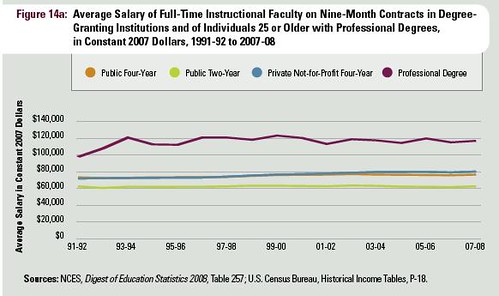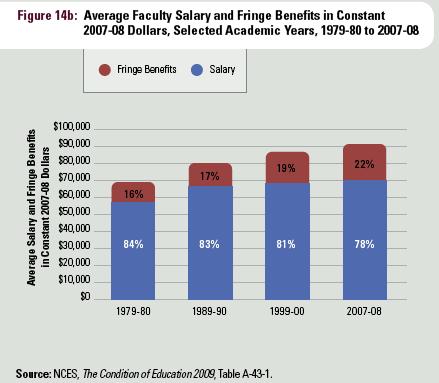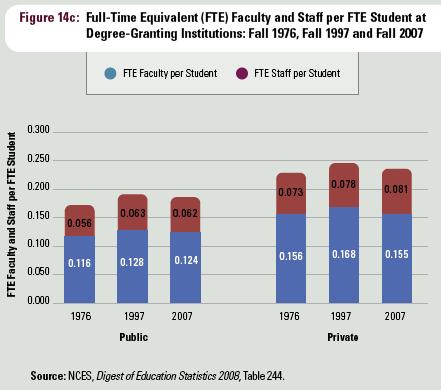At the risk of channeling my inner Bob Somerby, it seems that, in this fairly comprehensive NY Times article about the rising costs of college, there isn't any discussion about why these costs are spiraling. If it's a fixed cost, such as guaranteed faculty salary increases (snort), then that implies one solution. If it's a one-time cost (e.g., a massive spike in the cost of energy), then it's not much of an issue (or more accurately, there isn't much colleges can do about it). But nowhere in the article, is this discussed. Maybe I'm a wonky scientist or something, but I like to solve problems.
So I looked at the report (pdf).
It's not the faculty salaries:

There does seem to be a significant, but small (in terms of overall budget dollars) increase in fringe benefits (e.g., healthcare and retirement) for faculty:

(Interestingly, the percentage of benefits that is spent on healthcare has skyrocketed, which means that healthcare costs have eroded faculty retirement plans. Yay!)
And faculty, despite the stories of evil researchers who hate students and teach poorly, haven't decreased their student contact time compared to the mid-70s:

You'll also see in the above figure that the administrative burden, while higher than in the mid-90s, isn't that different from that in the mid-1970s. I can't really see any of these factors leading to five to eight percent annual increases.
So where the hell is all of the tuition money going? And shouldn't some enterprising reporter try to figure this out?
- Log in to post comments

Just to quickly note that the salaries in your figures are adjusted for inflation. Thus, several percent (NOT ALL) of the cost increases can be accounted for by inflation.
Other possibilities are that many colleges (particularly private ones) are spending more an more on campus improvement and extracurricular resources like student gyms. These attract students, but they also cost money.
There also seems to be a building repair boom... perhaps the huge amounts of baby boomer construction at colleges is creating a temporary increase in repair costs.
The increase in financial aid/schoalrships is probably not trivial. Full tuition is calculated assuming not everyone is able to pay. As fewer can afford the actual costs, those who can are picking up some slack.
Tuition is going up faster than inflation, so it's not just that.
My take on it is that colleges are building newer buildings and making their campuses look nice because they need to advertise and attract students to their schools. At this point, college is (at least for some) a requirement and not a choice, so it's mostly a matter of which one to go to. When the choice is no longer between "college or no college" and rather becomes "which college," then the competition changes from "is college worth the money?" to "is this college better than that college?" It's about comparing the costs and benefits of different schools, not comparing the costs and benefits of a school relative to no college at all.
One of the best selling points a college has is how nice the campus looks, how new the buildings are, how good your athletic facility/dorm rooms/science labs are, rather than how good the education is, how many faculty, etc. Most students are making the choice based on how their campus visit felt, not how good the school is. So there's an arms race between colleges to see who can have the nicest campus.
That's mostly unscientific though - I have no data to back that up. It's just based on my experience choosing a college, and
TECHNOLOGY, playing the keep up with the jones' in technology is very very expensive. Also students are spoiled, they want fancy schmancy dorms, wi fi, high speed networks for GAMING not study. I really think that is a lot of where money is going....into short term (most tech is obsolete in a few years) down the toilet spending.
(also in an effort to be 'cutting edge', schools buy early at premium rates, and on untested equip, wasting lots of money.
All of the above? And more?
Energy costs (heating and cooling), cost of goods purchased for maintaining buildings and the people who use them.
Not many costs for anything have gone down recently.
Lets see...
building maintenance and new buildings
groundskeeping
IT hardware, software, licenses (Microsoft is expensive when you've got 2,000-4,000 computers to license)
athletics, and more specifically athletics personnel. it's well documented that college football coaches have salaries well out of proportion to the rest of the school
campus security, with all of the legal issues and insurances involved - after Va Tech, every school has beefed up
but the real kicker (and you probably are hinting at it in trying to say "can't someone report on it") is this:
state funding cutbacks, combined with significant drops in alumni donations. tuition is going up because it has to make up for the money not coming from the traditional sources.
personally, i think colleges need to go for more obvious corporate sponsorship. GA Tech becomes the Coca-Cola Institute of Technology at Georgia!
and hey, under that scheme, Perdue wouldn't have to change a thing!
@Joe: State funding cutbacks are a major factor at state universities, yes, but do not apply to private universities, where tuition is rising at similar rates to state schools.
Building maintenance and construction costs: Yes and yes. Back in my undergrad days, there was lots of deferred maintenance on my campus (anecdotally, a lot of other places as well), and that eventually catches up with you. Especially when you need to keep a spruced-up campus, as Eric #2 noted.
Technology: Definitely yes. Typical computer replacement cycles have been ~ 3 years for the last decade plus, and upgrading OSs and applications also costs a significant amount of money (Microsoft being the worst but hardly the only offender). Also every classroom these days has to be equipped with an overhead LCD projector, as opposed to the viewgraph projector on a wheeled cart which was common in my time, and of which even a large department would only have a few. Retrofitting high-speed internet connections (which happened several times as the standard for "high-speed" rose to meet bandwidth demand) also adds up, though that should be less of a factor in the future with the rise of wireless networks.
Another factor is that education often cannot take advantage of all of the efficiencies of scale that most other industries can take advantage of. Classrooms have a maximum size, and there may be pedagogical reasons for maintaining student-to-faculty ratios in many classes, so the only ways to serve a larger student body are to hire more instructors or force more students to go on five- and six-year plans because they cannot enroll in required classes (obviously the latter solution is less than ideal).
Several factors have led to raises in tuition that exceed increases in costs. These (here in Illinois) are in order: decreasing state support, unfunded state mandates, costs of updating technological infrastructure, keeping up with student expectations. Over the past 30 years state support has dropped from about 2/3s of the cost of higher education to less than 1/4 of the cost. Tuition had to make up the difference to the point that we now refer to ourselves as a state assisted institution rather than a state supported institution.
At my institution, the major driver of costs is an exploding administration. The number of administrative positions have almost doubled in the past 10 years while the number of full-time faculty has actually decreased! That is a large source of the increasing costs!
Don't forget how that salary gets paid. It used to be in the old days, the state paid all and the tuition was purely functionary. Now that states are broke, I am guessing that a larger proportion on the salary is now paid by tuition. All you have to do is compare the cost of a state school ($8000 a year ) to a private school ($40,000).
I think the states cutting back on funding to the public universities is the biggest cause. This doesn't explain the rising costs at private schools however. But, are the costs at private schools really going up? The tuition may be increasing at private schools, but that does not mean their gross income from tuition is rising at all. Many private schools have ridiculously large endowments. In order to keep their qualification as non profits they have to spend so much a year. At many schools this means that a larger and larger % of the students aren't paying tuition at all. At schools like Standford if you come from a family that makes less than $100,000 you don't pay tuition. I assume that the schools (I don't have inside knowledge) raise tuition to keep things revenue neutral.
So I believe the public and private schools have rising tuition, but for different reasons.
(1) Capital investment.
(2) Administrator number and salaries.
(3) Reduced use of endowment income or legislative appropriations to cover operating expenses.
(4) Increased tuition remission rates (by private universities).
BTW, why is there dramatically more year-to-year variablility in the salaries of professional school faculty than the others?
This is just a guess, but the smaller population (only faculty at med and law schools) probably amplifies the variation. Or more accurately, the larger population in the 4-year schools does a better job of smoothing the curve.
My vote for a large chunk of it is the ever increasing number of vice-presidents, assistant deans, etc. and their ever increasing salaries. I expect that if you look at the number of times more money the presidents of universities make vs. the median faculty salary, that number is much larger now than in the 1970's.